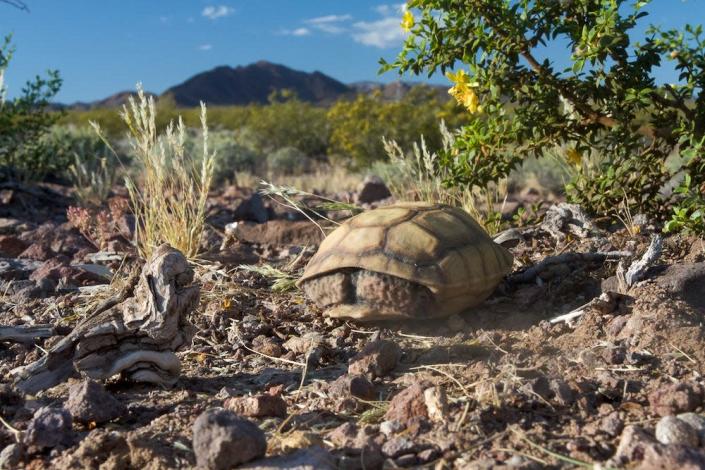Scientists use 3D-printed shells to ward off ravens and aim to save desert tortoises
Scientists use 3D-printed shells to ward off ravens and aim to save desert tortoises

In a video captured last year in Victorville, a raven can be seen pecking at a shell on the desert floor.
With scrub brush and electric transmission towers in the background, three other ravens stand nearby and watch with curiosity.
Without warning the shell hisses, emitting a spray that sends the birds flying.
Did the desert tortoise learn a new defense mechanism to fend off one of its biggest predators? Not quite.
But one company is hoping their invention will make ravens think twice before daring to mess with what they think is a defenseless reptile.
The booby-trapped shell was a Techno-tortoise, a 3D-printed model designed to look like a baby desert tortoise that was developed by Hardshell Labs, a company founded by Tim Shields.
Shields, a wildlife biologist with more than 35 years experience, said he was inspired to start his company eight years ago after seeing firsthand the decline of the slow-moving species.
Though the desert tortoise in the Mojave has been protected as a federally threatened species since 1990, scientists found in 2014 their numbers in the western Mojave Desert had dropped roughly 50% from those counted 10 years earlier.
Other studies estimate tortoise populations have collapsed as much as 90% since the 1980s.
As a contract field biologist for the Bureau of Land Management, Shields would spend upwards of three months living and studying in desert tortoise habitat, never seeing another human being.

In the early days, he’d see plenty of tortoises. That pattern changed as the years progressed.
“More and more, the track of my career has been from going from days that were absolutely packed with interactions with tortoises to now, a tortoise encounter being a rare event,” he said in a 2015 video.
Killer ravens
Scientists note several factors as contributing to the decline: Urban development destroying tortoise habitat, invasive plant species, disease, off-road racing and vehicle strikes.
For Shields, one factor stuck out above the rest as potentially solvable.
“There’s a lot of threats to tortoises, but raven predation seemed to be the one we could do something about,” he said in an interview Friday.
In contrast to the tortoises, common ravens flourish in the west. Once an uncommon bird to see in the western Mojave Desert, populations of the black bird rose 795% from 1968 to 2014, according to the Breeding Bird Survey.
Increased human presence in the region drove this explosion. With more people living in the desert, ravens can scavenge trash and roadkill, nest on electrical towers and dip their beaks in manmade sources of water.
They also use their beaks to poke holes and kill young tortoises. The reptiles are essentially defenseless to the attacks during the first decade or more of their lives because their shells aren’t as strong.
Scientists have found kill sites with dozens to hundreds of shells scattered beneath raven nests.
To save his beloved creatures, Shields said he had to switch from being a tortoise biologist to a raven biologist.
Since its inception in 2014, the main focus of Hardshell Labs is to invent technologies to prevent damage from birds.
Shields’ team in nests that could be 20 to 100 feet off the ground. The oil prevents the eggs from hatching while the raven parents remain unaware and continue nesting.
The first models of the Techno-tortoise, on the other hand, started off as just a simple lure to attract the birds.
Inspired by styrofoam tortoise models in the 1990s created by Bill Boarman, Hardshell’s lead scientist, Shields and his colleagues collaborated with the software company Autodesk to create something more lifelike using 3D-printing.
The initial decoy shells were used to calculate and understand the threat of ravens by measuring the rate of attacks.
Hardshell Labs deployed a wide spread of the rubes in 2018 and 2019 and sold about 1,000 to the U.S. Fish and Wildlife Service, Fast Company reported.
Later models were installed with sensors that would trigger a blast of bird repellent when fiddled with.
Five counter attacking shells were placed in the field along with cameras for the first time in spring 2021. One spot the Hardshell team picked was a popular roost in northern Victorville where Shields said 6,500 ravens have been recorded.
The results were exciting. Footage from one test showed an innocuous-looking shell scaring an aptly-named treachery, or group, of at least more than a dozen ravens into the air.
“So we know the device works. It does the first thing it needs to do which is scare the bejesus out of ravens,” Shields said. “Now we have to figure out, OK, if you get that effect does that reduce raven predation on tortoises. That’s a much harder question to answer.”
The biologist and others who use the shells hope the birds — which are considered one of the most intelligent animals on Earth — will learn and teach their brood to stay away from tortoises. Shields said he plans to test another 10 spraying shells in the field this year.
In the meantime, plans are being proposed to make the Techno-tortoise robotically mobile to even better deceive the ravens and keep them guessing. It's all an effort to save a reptile that Shields said he has an endearment toward.
“Tortoises just gave me a great life and I just want to keep them on the planet,” he said. “Earth would be a lot more boring without tortoises.”
MMW


Comments
Post a Comment